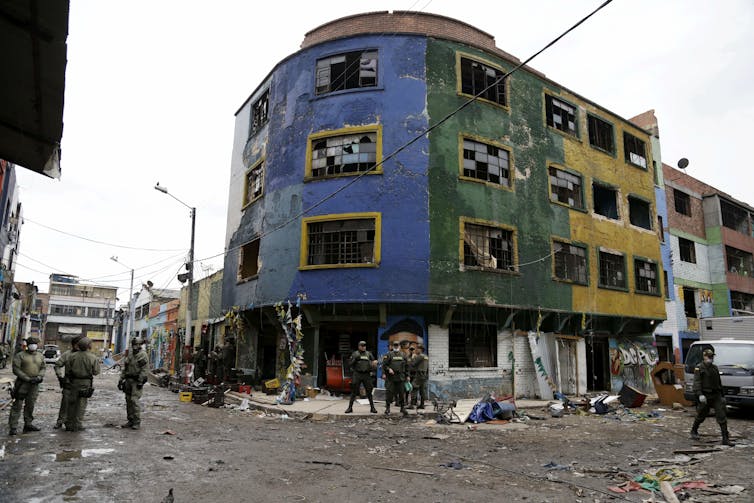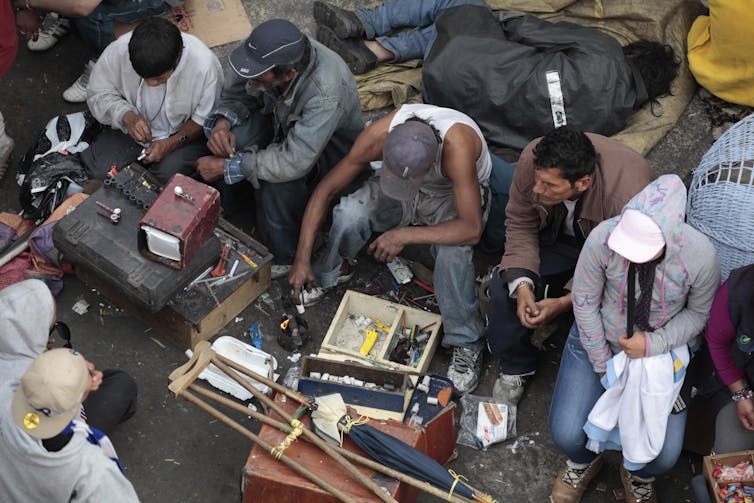It was just before rush hour on Aug. 23, 2017, when the Bogota, Colombia, district police and SWAT squad came for the gangs of El Cartuchito, an area with a potent illicit drug trade and open consumption of bazuco, a cocaine derivative similar to crack. Clad in anti-riot gear and armed with batons and tear gas, police were sent in, the city’s Department of Security later tweeted, to “reclaim” the area “for the citizens.”
That was the spin. In practice, the police actually vacated not just the drug gangs but also people guilty of nothing illegal, namely homeless people, people who use bazuco and garbage pickers. These activities, if socially frowned upon, are not crimes in Colombia, including the possession of drugs for personal consumption.
After forcibly removing everyone from El Cartuchito, the police gave residents a plastic snap-on bracelet, allowing them to return to the neighborhood.
The raid was just the latest aggressive operation to “clean up” Bogota. According to the city’s Department of Security, in 2016 there were 15 such raids on three “ollas,” or open-air drug scenes. Mayor Enrique Peñalosa, who entered office in 2016, insists that the crackdowns are a public safety necessity because Bogota’s ollas have become “operating centers for organized crime” where children are subject to “massive sexual exploitation.”
It’s true that Bogota faces a real security challenge in places like El Cartuchito, where homicide rates are acutely high. Alongside other researchers, I’ve been talking with people in the ollas for years about how the city could keep residents, including homeless children, safer. But it’s clear to me that a strategy of violent displacement followed by investment and gentrification is not the answer.
Uncovering the ‘olla’
The El Cartuchito raid was mild compared to what Peñalosa’s administration unleashed last year in an area called El Bronx. In May 2016, SWAT teams raided the downtown streets in the middle of the night, joined by child protective services and other city agencies.
Rousing sleeping homeless residents, often violently, police rounded up at least 2,000 people (estimates vary widely) and herded them into trucks, headed to an undisclosed location.
Those who refused to go were gradually driven out of the area, first into a plaza, then into surrounding ollas and, eventually, into a canal bed on Sixth Street.
There, police kept hundreds of people contained for weeks. At night, Bronx exiles told me, the officers would form a cordon to keep them from leaving the canal. Every third night, according to testimonies, police forced this group to move up or down the canal, apparently arbitrarily. I spent a night in the canal and witnessed the containment-and-sleep-deprivation strategy firsthand.
During one big rainstorm, multiple homeless citizens were washed away; one was later found dead.
Two local human rights organizations, CPAT and PARCES, whose May 2017 joint report details the brutal treatment of El Bronx residents, filed a complaint against Peñalosa’s administration in the Inter-American Human Rights Court. The case is pending.

After raids, all that remains of Bogota’s ollas are abandoned pets and the rubble of bulldozed buildings.
Fernando Vergara/AP
Just prior to the Bronx crackdown, in May 2016, the city had also cleared the Carrilera shantytown, burning down cardboard homes and dismantling shacks. “What are they doing? The government is trampling on poor people, on homeless people!” one witness said in an interview with El Espectador newspaper. “They gave us no alternatives, like a place to go, a place to live.”
Peñalosa’s slogan is “Bogotá, Better for All.” But all these raids have made many wonder: Is Bogota really for everyone?
The right to the city
This debate about who belongs in cities is longstanding. As the feminist geographer Melissa Wright has written, elite urbanites often equate progress with the disappearance of particular social groups who, in their eyes, degrade public space.
In 1990s-era New York City, Mayor Rudolph Giuliani cracked down on “quality of life crimes” like prostitution. More recently, the new mayor of São Paulo, Brazil, João Doria, razed a major downtown crack scene and homeless encampment.
Such efforts, sometimes called broken windows policing, reflect a belief that, to improve safety and urban progress, “undesirable” people and low-level crimes must disappear.
In Brazil, the constitution recognizes the citizenry’s right to the city, so several city agencies have questioned the legality of Doria’s raids.
Colombians have no such constitutional right, and data measuring Bogota’s homeless population are out-of-date and incomplete (a census of street dwellers is scheduled to begin in October).
People living on the streets of the capital routinely face harassment and police aggression. The Cartuchito and Bronx raids drove homeless residents and sex workers from the ollas, where most Bogota residents never saw them, and scattered them (as well as the criminals who operated in the ollas) throughout this city of eight million.
Many people did not welcome their new neighbors, the majority of whom are active drug users. Locals filed complaints, and there were reports of “donated” food being poisoned.
But urbanists and scholars have long recognized the right of every citizen to occupy public space. In a seminal 2008 article in the journal The New Left, the geographer David Harvey wrote that this is “one of the most precious yet most neglected of our human rights.”

Where’s their right to the city?
John Vizcaino/Reuters
The right to the city was also a theme of last year’s United Nations Habitat III conference, which focused on developing a “new urban agenda” for the world.
There’s no quick fix for urban inequality, but there are ways to promote progress in cities while respecting the rights of the most marginalized. Programs that offer social services, health care, housing and employment can help transform the lives of drug users. In the meantime, harm reduction services like needle exchange and peer education can reduce risky behaviors.
In a report on El Bronx released on Sept. 27 by the University of the Andes’ Center for the Study of Security and Drugs, the researchers consider what state-sponsored treatment options would be legally viable in Colombia and recommend exploring experimental health strategies tailored to the needs of Bogota’s bazuco users.
Such efforts were starting to get underway in prior mayoral administrations, and from 2012 to 2016 the city operated mobile health centers for drug users in El Bronx. But Peñalosa quickly phased out these projects.
Everyone ousted from El Cartuchito, El Bronx, and other “reclaimed” areas share one thing: they are all street-connected, meaning that their daily activities take place largely in public. In denying such people their right to the city, Bogota officials are essentially denying them their right to exist.
>>> Read full article>>>
Copyright for syndicated content belongs to the linked Source : TheConversation – https://theconversation.com/who-are-the-real-targets-of-bogotas-crackdown-on-crime-83949































